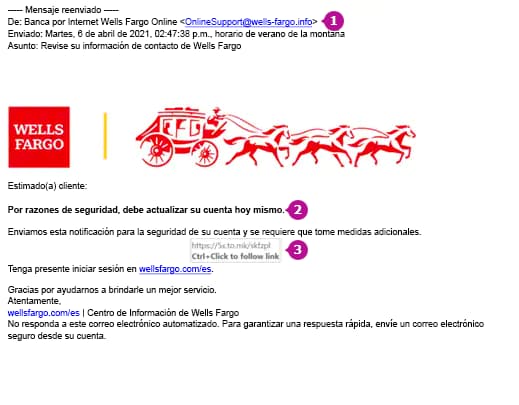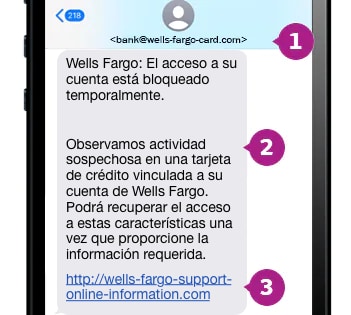Las estafas de suplantación de identidad (phishing) pueden provenir de estafadores a través de mensajes de texto, correos electrónicos o llamadas telefónicas y, a menudo, usan un tono urgente para presionarle a actuar rápidamente.
Los estafadores podrían presentarse como alguien que usted conoce o como una organización legítima para solicitar un pago inmediato o información sensible.
Recuerde: No comparta su número de identificación personal (PIN, por sus siglas en inglés), contraseña de la banca por Internet o códigos de acceso por única vez con nadie. Wells Fargo no se comunicará con usted para solicitarle esta información.
Estos cinco pasos le ayudarán a detectar, evitar y reportar intentos de suplantación de identidad (phishing).
Paso 1: Esté alerta. Conozca las señales de advertencia de una suplantación de identidad (phishing).
Los mensajes de suplantación de identidad (phishing) pueden usar inteligencia artificial (IA) para imitar hábilmente a su banco, una agencia gubernamental u otra organización que usted reconozca o en la que confíe.
Estos son dos ejemplos de suplantación de identidad (phishing) que imitan las comunicaciones de Wells Fargo.

Ejemplo de correo electrónico de suplantación de identidad (phishing)
- Preste atención a las direcciones de correo electrónico que no incluyan “wellsfargo.com”.
- Tenga cuidado con las alertas urgentes donde se le pida que actúe de manera inmediata.
- Evite hacer clic en enlaces o llamar a números que no reconozca.
Si tiene dudas, inicie sesión en la banca por Internet Wells Fargo Online® o comuníquese con nosotros directamente llamando al número de teléfono que aparece al dorso de su tarjeta.

Ejemplo de mensaje de texto de suplantación de identidad (phishing)
- Tenga cuidado con remitentes que usan una dirección o un número de teléfono que no reconoce. Los códigos abreviados comunes de Wells Fargo incluyen 93557, 93733, 93729, 93767, 20342, 22981 o 93000.
- No responda a alertas que le soliciten que proporcione información de acceso a su cuenta privada.
- Evite hacer clic en enlaces o llamar a números que no reconozca.
Si tiene dudas, inicie sesión en la banca por Internet Wells Fargo Online® o comuníquese con nosotros directamente llamando al número de teléfono que aparece al dorso de su tarjeta.
Paso 2: Haga una pausa. No se apresure cuando detecte una falsa urgencia.
Los intentos de suplantación de identidad (phishing) a menudo llegan como una solicitud urgente.
Sospeche de los mensajes que anuncian un “problema” con su cuenta o le piden que inicie sesión de inmediato para desbloquear su cuenta, verificar una transacción, realizar un pago por Internet o revertir un pago.
Cuando se le pida que “actúe de inmediato”, haga lo contrario. No se apure y resista el impulso de responder de inmediato.
Paso 3: Verifique. Confirme el remitente, pero no confíe en el identificador de llamadas.
Los intentos de suplantación de identidad (phishing) pueden ser sofisticados e incluso podrían falsificar (o imitar) el identificador de llamada para que la llamada parezca legítima.
No asuma que una comunicación puede ser confiable simplemente porque parece o suena legítima.
Póngase en contacto con la organización directamente yendo a su sitio Web.
Para verificar las comunicaciones que parecen ser de Wells Fargo, inicie sesión en la app de Wells Fargo Mobile® o escriba “wellsfargo.com/es” en una nueva ficha del navegador para acceder directamente a la banca por Internet Wells Fargo Online®.
Obtenga más información sobre las estafas de impostores bancarios.
Paso 4: Deténgase. Cuando tenga dudas, no responda.
Cuando reciba una solicitud urgente que le parezca sospechosa, cuelgue o cierre el mensaje. No está siendo grosero: está siendo sabio.
Medidas que debe evitar:
- No inicie sesión en su cuenta de Wells Fargo desde un enlace en un mensaje sospechoso
- No comparta información de su cuenta personal, como su número de identificación personal (PIN, por sus siglas en inglés), su contraseña o códigos de acceso por única vez
- No haga clic en ningún enlace ni abra archivos adjuntos, ya que pueden instalar malware en su dispositivo
- No llame a los números de teléfono incluidos en la comunicación
- No permita el acceso remoto a su computadora
Sugerencia
Paso 5: Permítanos ayudarle. Reporte una suplantación de identidad (phishing) si sucede.
Asegúrese de utilizar la app de Wells Fargo Mobile® para monitorear de manera periódica su cuenta en busca de actividades sospechosas. También puede activar alertas adicionales para que se le notifique de transacciones y retiros.
Si ha sido víctima de una suplantación de identidad (phishing)
Llámenos de inmediato al 1-866-867-5568 (en inglés) si hizo clic en un enlace, abrió un archivo adjunto, envió un pago o proporcionó información personal o financiera en respuesta a un mensaje sospechoso.
Si detectó un intento de suplantación de identidad (phishing)
Si ve un mensaje sospechoso que menciona a Wells Fargo pero usted no ha hecho clic en el enlace ni ha abierto ningún archivo adjunto, envíenos el mensaje a reportphish@wellsfargo.com y luego elimínelo. Recibirá una respuesta automatizada.
Si el mensaje sospechoso no está relacionado con Wells Fargo, considere comunicarse directamente con esa organización para reportar el incidente.
Cuándo reportar el fraude
Si sospecha que fue víctima de un fraude relacionado con su cuenta de Wells Fargo , comuníquese con nosotros de inmediato.
Obtenga más información sobre cómo puede ayudar de forma proactiva a proteger su cuenta de Wells Fargo .

 Inicie sesión
Inicie sesión 